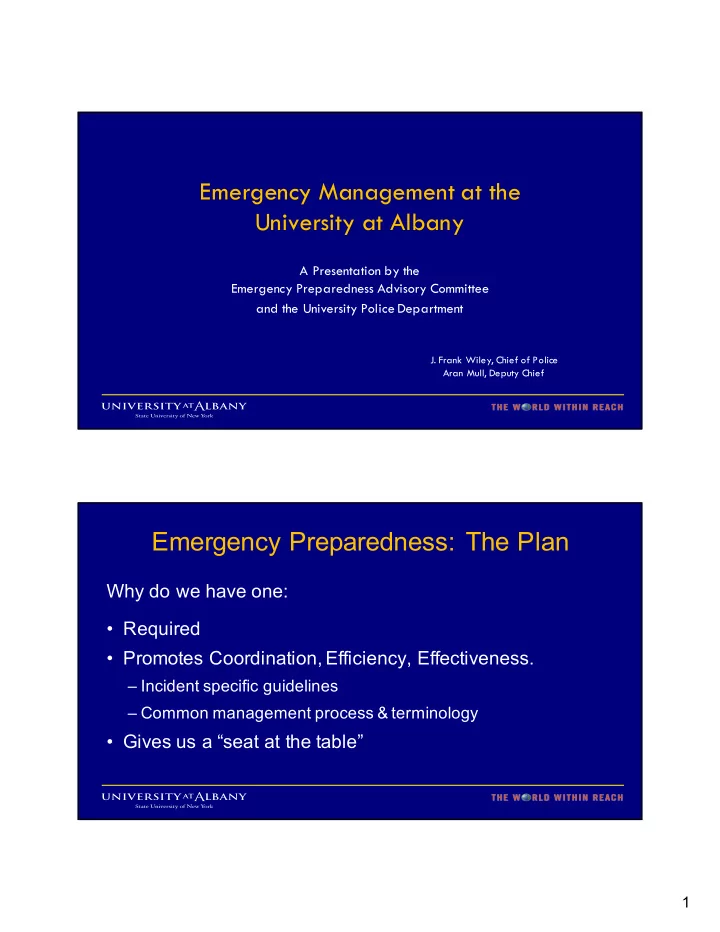

Emergency Management at the University at Albany A Presentation by the Emergency Preparedness Advisory Committee and the University Police Department J. Frank Wiley, Chief of Police Aran Mull, Deputy Chief Emergency Preparedness: The Plan Why do we have one: • Required • Promotes Coordination, Efficiency, Effectiveness. – Incident specific guidelines – Common management process & terminology • Gives us a “seat at the table” 1
Emergency Preparedness: The Plan Guideline for: • Incident Typing (General Response Protocols) • Incident Classification (Fire, HazMat, Criminal) • Activation: Authority & Process • Position Responsibilities Available to community on My UAlbany portal Emergency Preparedness: Using It • We haven’t (outside of exercises) • Addressing Potential Issues – Prevention – Mitigation 2
Emergency Preparedness: Exercise Water Main Break – Evaluating: • Ability to Activate and Staff EOC (Functional Drill) • Capability to operate using the NIMS Incident Command System to manage the incident • Capability to identify and manage issues resulting from the incident • Test operational response to the incident Emergency Preparedness: Next Steps • IDENTIFY committed individuals for Emergency Operations Center • COMMIT University funds for appropriate training of individuals and equipping of the EOC • DETERMINE the appropriate structure for the University emergency response system 3
Vigilance Without Fear: Active Shooter Incidents Active Shooters: Context (1) • Active shootings are very rare events. The New York Times Reports that the chances of dying from a terrorist related incident from 2007-2013 was one in twenty million. Consider for instance, that since the attacks of September 11, 2001, Americans have been no more likely to die at the hands of a terrorist than being crushed to death by unstable televisions and furniture. 4
Active Shooters: Context (2) • Even in countries that have been targets of intensive terror campaigns, such as Israel, the weekly number of casualties almost never comes close to the number of traffic deaths. • But when a terrorist attack occurs, it is tragic. It causes untold grief and devastates the society causing disproportional fear. Unfortunately, terrorist attacks are increasing. It is therefore important to be vigilant without fear. Are we Prepared? • Partnerships – no one can do it alone • CARE team • Federal, state, and local LE • Local campus police/public safety & SUNY Chiefs • Focus on: Education, Prevention, Mitigation 5
Education • UPD’s training program has more than 14 years of development • Train with other departments and in University spaces • LE training brought to campus partners • CARE team • Faculty/staff groups • Citizen Police Academy • Web page videos & response information • Training includes FBI’s “10 Signs Of Radicalization” and information on the Detection of Suspicious Activity Prevention • CARE team • UPD’s intelligence reports monitoring former students/faculty/staff • Promoting/enabling reporting concerns • Publicizing efforts (if it is going to happen let it happen elsewhere) 6
Recognizing signs of Potential Workplace Violence AN ACTIVE SHOOTER MAY BE A CURRENT OR FORMER EMPLOYEE. ALERT YOUR HUMAN RESOURCES DEPARTMENT IF YOU BELIEVE AN EMPLOYEE EXHIBITS POTENTIALLY VIOLENT BEHAVIOR. INDICATORS OF POTENTIALLY VIOLENT BEHAVIOR MAY INCLUDE ONE OR MORE OF THE FOLLOWING: • Increased use of alcohol and/or illegal drugs • Unexplained increase in absenteeism, and/or vague physical complaints • Depression/Withdrawal • Increased severe mood swings, and noticeably unstable or emotional responses • Increasingly talks of problems at home • Increase in unsolicited comments about violence, firearms, and other dangerous weapons and violent crimes Mitigation • UPD response capability and tactics informed by: • Previous events (e.g., DHS report on tactics used in Paris) • Incorporation of training developments (NTOA, LASER, ALERRT, etc.) • Equipment • Consistent semiannual training 7
How to Respond Interacting with Law Enforcement 2. INFORMATION YOU SHOULD PROVIDE 1. HOW YOU SHOULD REACT WHEN TO LAW ENFORCEMENT OR 911 LAW ENFORCEMENT ARRIVES: OPERATOR: – Remain calm, and follow officers’ – Location of the active shooter instructions – Number of shooters, if more than one – Immediately raise hands and spread fingers – Physical description of shooter/s – Keep hands visible at all times – Number and type of weapons held by – Avoid making quick movements toward the shooter/s officers such as attempting to hold on to – Number of potential victims at the them for safety location – Avoid pointing, screaming and/or yelling – Do not stop to ask officers for help or direction when evacuating, just proceed in the direction from which officers are entering the premises 8
A word about UPD’s Preparation All of our officers train regularly to immediately respond to the scene of an attack and stop a threat as quickly as possible. To make our officers as effective as possible, we have equipped them with patrol rifles capable of greater accuracy and with the ability to defeat body armor. We train our officers on a variety of tactics to integrate with area agencies that would likely assist us during an incident. Our officers train on both the US Homeland Security’s LASER concept as well as the FBI’s ALERRT system. We utilize force on force simulation training semi-annually to reinforce these concepts and build confidence and proficiency. Our officers are also trained on breaching techniques to enable them to gain access to areas barricaded by a shooter, and we have an explosives K9 team to assist in the detection of any IEDs that may be incorporated into an attack. Questions? See something, Say something! Call UPD at 518-442-3131 Save in your cell phone under “U” Please visit our website at http://police.albany.edu/ 9
Recommend
More recommend